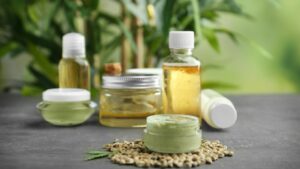As our planet’s health continues to decline, it’s become more critical than ever to make sustainable choices. Green products, those made with minimal impact on the environment, are not just a trend, but a necessity. But what exactly are these products, and how can they be incorporated into our daily lives?
Green Products Examples
 Green products, also known as eco-friendly or sustainable products, encompass items that cause minimal harm to the environment during their production, use, and disposal stages. Unlike their conventional counterparts, these resources embrace a ‘cradle-to-cradle’ design approach, with low emissions, efficient use of energy, and little to no waste. Key examples encompass everything from biodegradable cleaning products to organic foods and even renewable energy systems.
Green products, also known as eco-friendly or sustainable products, encompass items that cause minimal harm to the environment during their production, use, and disposal stages. Unlike their conventional counterparts, these resources embrace a ‘cradle-to-cradle’ design approach, with low emissions, efficient use of energy, and little to no waste. Key examples encompass everything from biodegradable cleaning products to organic foods and even renewable energy systems.
It’s essential to understand the meaning of a few terms attached to green products. ‘Biodegradable’ signifies that an item can naturally decompose, fading into the environment over time. ‘Non-toxic’, on the other hand, implies that a product contains no components harmful to humans or wildlife. A ‘renewable’ product employs materials that nature can replenish, ensuring sustainability. The evaluation of green products includes their life cycle assessment, focusing on the environmental impact from the extraction of raw materials to the product’s disposal.
Recognizing green products becomes more effortless when equipped with these insights. The next step involves identifying and choosing these resources in various market sectors to support the preservation of the planet.
Types of Green Products
Expanding on the idea of green products, it’s crucial to explore their various types. Among them, green household items, green personal care products, and green food products have gained prominence for their eco-friendliness.
Green household items extend beyond recyclable goods. They encompass items, such as solar-powered light fixtures and organic cotton bedding. These products align with the principles of sustainability, and their production processes involve minimal environmental damage.
Green personal care products are enriching the market. Items, for instance, shampoo bars and organic body lotions, stand as testaments to a shift in consumer trends towards sustainability. These products are non-toxic, contain natural ingredients, and come in recyclable packaging.
Finally, green food products, such as organic fruits and vegetables, fair-trade coffee, and sustainably caught fish, are lauded for their eco-friendly growing and production practices. They’re free from synthetic pesticides, and their cultivation promotes soil health.
By recognizing these types of green products, consumers can make informed de
cisions, contributing meaningfully to environmental sustainability.
Green Products Examples

Firstly, diving deeper into household items, solar-powered fixtures illuminate homes with minimal energy consumption. This reduces reliance on fossil fuels, promoting a healthier environment. Organic bedding is another exemplary green product, made from natural fibers without harmful chemicals.
Shifting focus to personal care, shampoo bars make a great alternative to traditional bottles. They cut down on plastic waste and often contain natural ingredients. Organic lotions, free from synthetic chemicals, benefit the user’s skin and the ecosystem alike.
Lastly, in the food sector, sourcing organic fruits is a simple green choice. These edibles bypass harmful pesticides, offering healthier and greener consumables. Fair-trade coffee also makes the cut, supporting sustainable farming and ethical practices.
These green products examples signify the possibilities for consumers to incorporate sustainability into their everyday lives. Each purchase is a step towards environmental preservation, embodying the potential for profound collective impact.
Advantages and Disadvantages of Green Products
Harnessing the power of green products enjoys a host of perks. Foremost, they promote environmental well-being. Reduced levels of toxic substances and the ensuing lesser risk of illnesses stand as testament to their benefits. Additionally, they enhance biodiversity, foster sustainability, and contribute crucially to reducing the global carbon footprint. For instance, solar-powered fixtures lessen dependence on fossil fuels, thereby decreasing carbon emissions.
However, one must weigh these merits against certain disadvantages. Primarily, green products often come with a heftier price tag, limiting their accessibility for many consumers. Furthermore, the term ‘green’ remains loosely defined and unregulated, potentially leading to ‘greenwashing.’ For instance, while a product may claim to be ‘organic’, there’s no guarantee that it’s entirely free of harsh chemicals.

